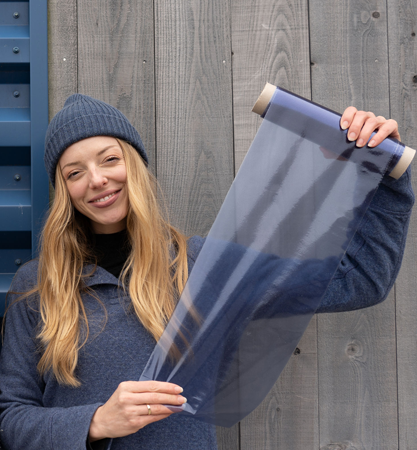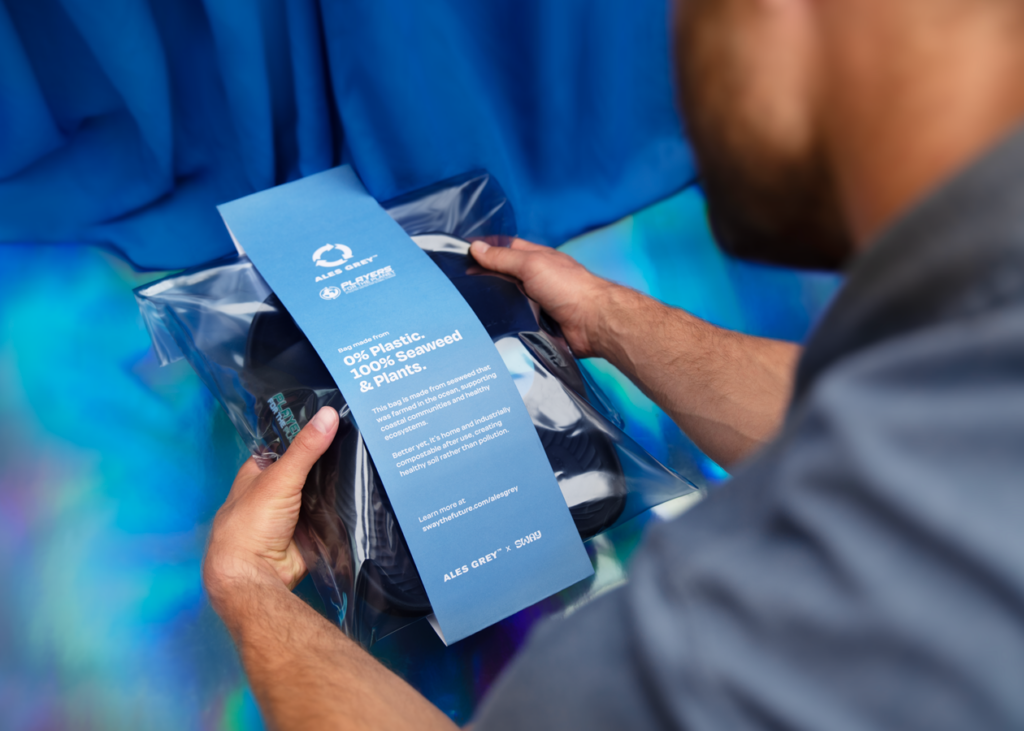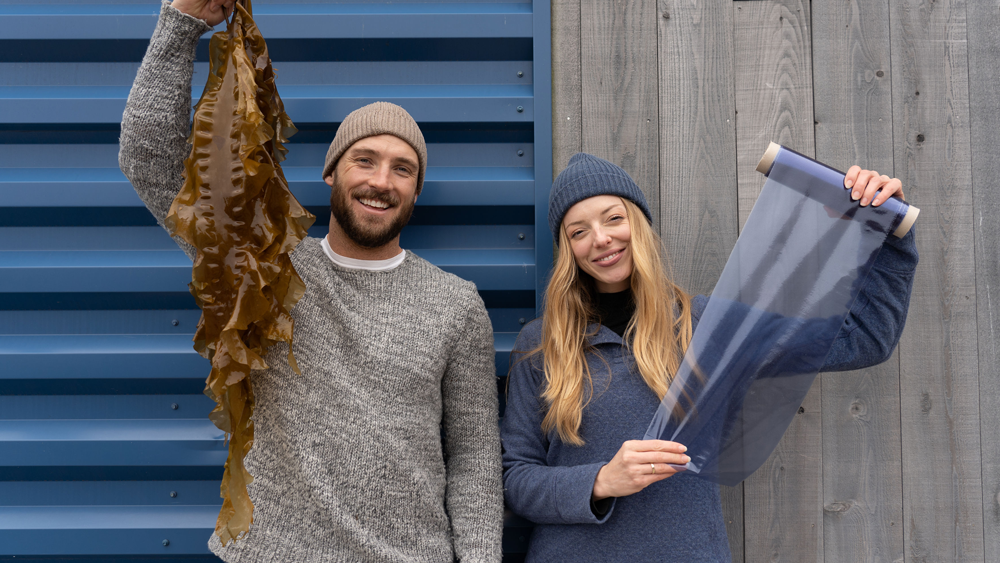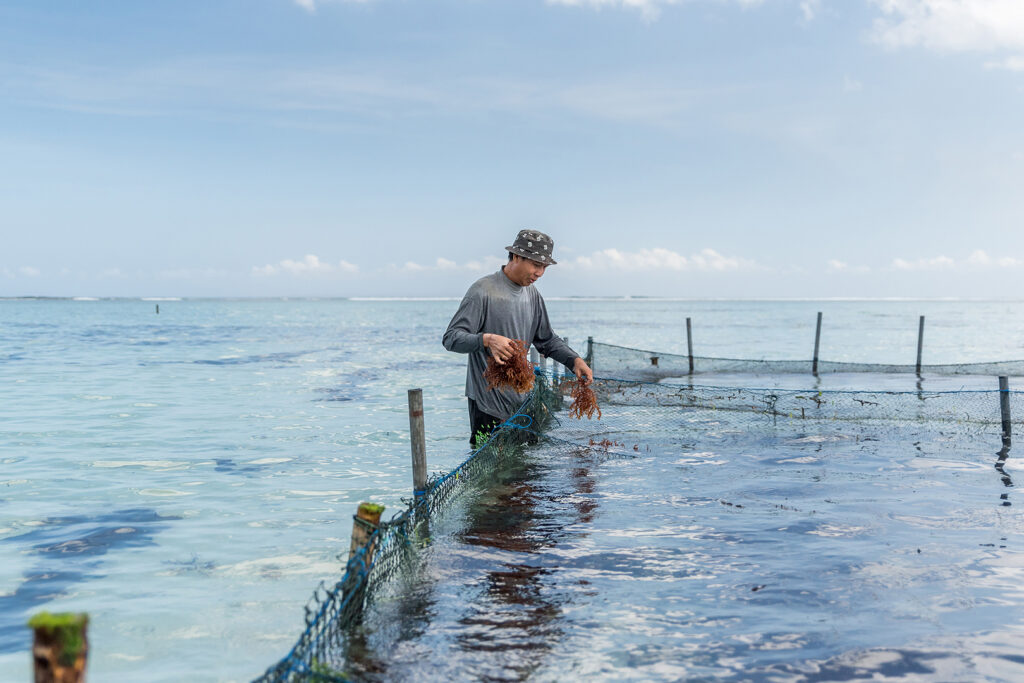
Julia Marsh
Co-Founder & CEO
Location / Year Founded / Industry:
California / 2020 / Climate Tech
What is Sway?
Sway is displacing petroleum-based plastic packaging with cost-competitive biodegradable alternatives made from seaweed, a regenerative feedstock that not only stores carbon but recycles it.
Why it matters:
Twelve million tons of plastic end up in the ocean every year—that is an entire garbage truck’s worth of plastic dumped into the sea every minute, none of which is biodegradable. Sway’s products are completely biodegradable in marine and soil environments, as well as home-compostable, within 30 days. Most notably, their degradation does not contain microplastics.
Why you should care:
Current bioplastics made from corn and soy, which are the basis for most “compostable” packaging on the market today, have proved insufficient to tackle the $382B global plastic industry: they don't decompose outside of industrial facilities, are often too expensive, resource intensive, and don’t work with current manufacturing infrastructure that produces film plastics. Sway’s patented technology—a thermoplastic seaweed resin that is an entirely new category of biopolymer—is the first of its kind to work within traditional plastic infrastructure as a B2B “drop-in” solution allowing for rapid scale..
“Designers make great founders because they make the impossible visible for others,” explains Julia Marsh, co-founder of Sway, who spent over a decade building brand and packaging systems for consumer goods companies and technology startups including EVO and Brandless. Frustrated with the lackluster alternatives to plastic packaging, she became obsessed with untapped feedstocks for bio-plastics. “Brands trying to move away from plastics are presented with a few options—there’s corn, potato, sugarcane, and trees, inputs that are resource-intensive and not majority bio-based content. They don’t decompose and they’re too expensive,” she says. “Packaging, as a whole, is a generally overlooked category for innovation, but it will have an outsized impact on the climate when we figure out new materials and how to scale them.”
Julia applied to the School of Visual Arts to earn her Master’s degree in Designer as Entrepreneur (also known as the “business school for designers”), and set out to design new building blocks for packaging alternatives that actively replenish environmental health. “This is how we landed on Sway,” she says. With her life partner and co-founder Matt Mayes, Julia developed a competitive alternative to petroleum-based plastic film packaging; their patented technology—a thermoplastic seaweed resin that is an entirely new category of biopolymer—is the first of its kind to work within traditional plastic infrastructure as a B2B “drop-in” solution, enabling Sway to replace plastic for virtually any application in the food, fashion, and home goods industries. Their products include shopping bags, standup pouches, food packets, bar wrappers, and mailers that will either backyard compost in weeks or dissolve in hot water rather than persist for centuries.

“Our mandate at Sway is to match or exceed the performance of traditional plastic with products that replenish the planet. We’ve designed our company to ensure it scales and competes on cost—it’s got to perform, it has to biodegrade, and it has to create impact at every step of the supply chain.” Indeed, since launching in 2020, Sway has been recognized as superior to its competition in scalability, cost, performance, biological degradation, and environmental impact, winning first place in the TOM FORD Plastic Innovation Prize, a year-long technical review of 64 biodegradable plastic alternatives.
The Helm is thrilled to back Julia and Matt’s vision to bring benevolent materials into the mainstream, supporting the health of oceans, communities, and land along the way. We participated in Sway’s $5M Seed round in 2023, alongside Third Nature (Beyond Meat, Keel Labs, and Myco Technology), One Small Planet, and BAM Ventures. Read more in our interview with Julia below.
As a designer, yours is a common founder journey—frustrated by a problem you’re encountering—but for non-technical founders, there can be a huge barrier to entry. You first came up with Sway’s thesis during grad school. How did you go from idea to business opportunity?
Given that so much waste is determined at the design stage, I wanted to understand how we could embody principles of the circular economy in a new or an overlooked way, so I started doing deep research on all the different potential feedstocks that could be used to replace plastics. When you’re in grad school, you have a golden ticket—I could talk to anybody. I had access to the most amazing experts in this field, including iconic designers like Stefan Sagmeister, Louise Fili, and Brian Collins, as well as people like Andrew Dent, the president of Material Connection, a library of all the materials available to designers globally, and he was able to put me in contact with specialists. I also connected with seaweed farms and farmers, like Dr. Michael Graham from Monterey Bay Seaweeds, and founders building other novel materials, like Charlie Dimmler and Genet Garamendi at Checkerspot who are using microalgae oil; they lent insight into what it is really like to work with biomaterials. We had access to advisors across the value chain.
After researching all the different feedstocks (corn, potato, trees, sugar, etc.) I had a basic understanding of the trade-offs for each. This is where Matt, who was pursuing a master’s degree in sustainable development practice, came in. I lacked the real-world perspective of supply chain, logistics, and life cycle analysis, so he was able to supplement my early research. We both arrived at seaweed as being the most available, impactful, and untapped resource to work with, which led us to visit seaweed farms in Indonesia during the summer between our first and second year.

Together, we built the foundation of Sway along with Leland Maschmeyer, our third co-founder, who now acts as a formal advisor. As the former Chief Brand Officer at Chobani and founder of the design from Collins, he’s foundational to how we think about scale. Even though it was a thesis, Sway was built through this real passion and desire to make this change happen. Not in the hypothetical, but in the real world. That’s how it became more of a real business concept.
Why seaweed?
Seaweed checks all the boxes. It’s been growing on this planet for a billion years, it’s super diverse with 12,000 species, and to cultivate seaweed you don’t need fresh water, you don’t need fertilizer, you don’t need land. If we want to build a climate positive future, we should be looking for resources like this.
Most people think of seaweed as a snack you buy at Costco, but there are natural polymers inside of seaweed that offer jelling properties already used commercially in donut glaze, toothpaste and lotions. It’s the reason your moisturizer is smooth. It’s a really well established industry that up until this point hasn’t had a market beyond food and pharmaceuticals.
The other reason is that when seaweed is cultivated, it’s actively mitigating the effects of climate change. Seaweed has this immense capacity to store carbon. It has the ability to cycle excess nutrients and combat the effects of ocean acidification. It also provides habitat for biodiverse life. And you can cultivate seaweed without impacting the environment. It’s functionally only a net positive for ocean health and it’s regenerating social systems, as well. There are communities that have been impacted by overfishing and warming waters and seaweed cultivation presents a resilient employment opportunity.
How did you build the first prototype for Sway?
I ordered seaweed off the internet and mixed it in our Brooklyn kitchen [laughs]. You can look up how to make seaweed bioplastic on YouTube—as a science project in your house, anyone can do this. What’s special is knowing how to design it to work with existing infrastructure.
I was making cups and plates and then began experimenting with whether I could create films using the help of a material engineer friend. My first prototypes were very rudimentary; extremely ugly and very bad, but they were good enough. I thought if I, with no talent in this space, could make something that resembles plastic, then certainly if I hired someone from the plastic industry, they could make it real.
At this point, a handful of seaweed packaging competitors had already launched. When did you decide that your model—working with traditional plastic manufacturing to scale rapidly—would be your big differentiator?
As a function of the thesis and the research I was doing around new materials, I was vetting all the potential competitors and seaweed players in this space and realized they’re all using novel machinery and equipment. To make this at scale, I knew we had to work in partnership with the plastic industry. A lot of the research that was happening felt very academic or gimmicky rather than a true commercial opportunity, which informed how we built the foundation of Sway. These products need to scale. We’re not trying to vertically integrate, we’re designing for the system that exists to scale up with co-manufacturer partners.
A lot of the research felt very academic or gimmicky rather than a true commercial opportunity, which informed how we built the foundation of Sway.
That’s why the first full-time hire we made was our senior materials engineer who came from Big Plastic. He found us via Instagram, after I set up an account to talk about our vision and how these materials could work. He was desperate to make materials that were impactful and after interviewing a shocking number of people given how bare-bones of a company we were at that stage, we offered him the job. Two weeks later he drove across the country with everything in his trunk, including his cat, and set up our first lab in our garage. That’s how we got our start.
It took two years to turn your prototype into a product. Tell us about that process.
There is a huge barrier to anyone trying to do material innovation: you need access to so much equipment. If you want to design for what already exists, you need access to what exists, so our foundational research was all oriented around when we have access to this equipment, our product should work.
We incrementally gained more and more access to foundational pilot equipment by building relationships with the USDA, and after we raised our first round, we built our initial lab and worked with manufacturers who could scale our tech. Validating it with customers was the lever that enabled us, very early on, to say, “If we build it, they will come. We’re really onto something. Seaweed can be designed for scale. Here’s the proof.”
What were some of the biggest challenges you faced?
The plastic industry is really inefficient and old-fashioned. A lot of people in the plastic industry have been doing this for longer than I’ve been alive, so for them to take Sway—and specifically me—seriously, was a huge challenge. There was a large amount of skepticism because there have been so many new materials that have tried and failed in these systems.
What we consistently ran up against, especially in our first year, was begging people to give us their time and access to their machinery to test our materials. But the most rewarding piece of this innovation is that when we do get their time and they see the material run, the light bulb goes off. You can see the excitement in their eyes that the material can actually bring these traditional plastic manufacturers into the environmental movement.
Several of our portfolio companies are family co-founders: mother and daughter or husband and wife, which can be a red flag for investors—but we view it as a secret sauce. Tell us about the decision to found the company together and why it works so well.
We were at a similar place in life regarding our careers and our desire to create more impact in the world. We were both earning our master’s degrees, steeped in research, and confronted with the shortcomings of the way innovation happens. Either through my experience trying to source new materials or through Matt’s experience trying to recommend solutions to businesses that were more sustainable, we were very aware of the shortcomings. It was a timing component.

The aha! moment happened in Indonesia when we visited our first tropical seaweed farm. You get to see first-hand how this industry, which has been around for hundreds of years, requires so little—just rope, twine, and time—and you realize there should be more of it. Matt grew up on a farm, he knows how industrial agriculture works. Seaweed aquaculture is all the things that we wish industrial agriculture could be.
We incorporated the company together in 2020 and our skill sets are completely complimentary. I cannot do the things that Matt does and he can’t do the things that I do. I need the pragmatism and the patience for the mundane that he has, and he needs my permanently optimistic viewpoint to balance that out. These are the two halves that make business function. I’ve heard it described as sandboxes in the past: I don’t play in his sandbox and he doesn’t play in mine. That enables us to own different aspects of the business in what I think is a very sustainable model. On the personal side of it, when we have a victory, we share that completely. It’s so amazing that your life partner can feel fully invested in those victories and can fully empathize with the losses.
How did you settle on roles and how do you divide responsibilities?
There was never a question about the roles we would play. It was obvious that I would be the leader of the company; I come from the packaging world, I speak this language, and it was originally my core vision. Matt straddles two roles for us at Sway: he is our COO and Chief Sustainability Officer, which speaks to his background and set of expertise. He manages multiple roles and it was very natural.
One reason we had such confidence we could build a business together in addition to the foundation of our relationship, was post-graduation from our master’s programs when we visited Sway’s potential seaweed supply chain. Matt and I built out a rig and drove from Berkeley to Peru visiting farms and biomaterial innovators over six months. The goal was to get to the southernmost tip of Chile where one of our largest seaweed suppliers is now based. There’s no better test for a couple, period, let alone the founders of a business, to navigate Central America, Columbia, Ecuador, and Peru in a rig, going through mountains and jungles, climbing volcanoes, repairing the vehicle when it broke down, and sustaining ourselves off the grid. We had an amazing time. So, we felt like yeah, we could probably build a business together.
I think both of us are exceptionally practical when it comes to wanting Sway to succeed. The work is too important, the mission is too important. We’re going to prioritize whatever it takes to make Sway succeed.
You recently closed a $5M Seed round. We know that less than 2% of venture capital goes to female-founded companies. What was your fundraising experience like?
We raised our Seed round in an especially difficult year. Multiple wars, financial collapse, and a generally frosty fundraising environment made everything more difficult. Our specific fundraising process included exposure to dozens of incredible funds focused on climate, food, oceans, and conscious consumerism. The challenges we ran into were primarily related to our stage—inventing new materials takes time. Our business is not as straightforward as your typical tech startup. As we were fundraising, we were simultaneously launching our flagship products. Those who joined the round understood this!
Along the way I learned to lean into discomfort.
I’d add that as a female founder, it wasn’t until this raise that I became aware of the bias I was receiving. The difference when Matt was on the call was so stark: people taking me seriously or not, listening to the facts I was sharing versus when he would say them was shocking. I also experienced investors feeling uncomfortable communicating or having a real conversation with me if I took a call alone. If Matt on a call, they would start asking real questions—on all aspects of the business, things that I run at the company. Conscious or unconscious, bias often seeps in, regardless of how sound the fundamentals of our business and mission are, not to mention all the incredible traction we’ve garnered. Looking back, many of our more successful conversations happened when Matt was in the room.
Along the way I learned to lean into discomfort. I really benefit from the wisdom of my team and our advisors to support the areas of the business I’m less of an expert in, and I’ve learned a lot in the process. I also learned the power of making the solution feel tangible, of showcasing our materials and enabling folks to touch the future. Showing up in person goes a long way.
What do you look for in an investor?
Empathy to the founder experience, which to us simply means being on board with the vision, even in the face of ambiguity. We also love operators and specialists; those who are willing to roll up their sleeves and help us in areas beyond fundraising. And finally, as a mission-led organization, we prioritize authenticity. Earnest conversations build trust in navigating the ups and downs of startup life.
You’re a small team of seven. As you enter a stage of growth, how do you think about hiring and creating a culture reflective of your values?
We hire for mission alignment in addition to domain expertise, and folks who can operate independently—each individual owns an entire segment of the company. We prioritize resourcefulness. Even though every person on the team came to Sway for a different impact area, whether they care about eliminating plastic, ocean conservation, or access to conscious consumerism, it unifies us.
As a company, we target distance traveled over any certificate, diploma,or pedigree. It’s not about seeking the Harvard MBA, it’s about the person with a bachelor’s who spent five years working their way up in various relevant industries, someone who has displayed scrappiness.
We were very fortunate after Sway’s incorporation to have the help of founding members who were fellows at the time for the company. These fellows worked their way towards being full-time hires for the company, but we’ve made some serious step changes in the evolution as a business and as such, we outgrew some of these persons. We loved them. They were key to Sway’s success thus far, but we understood that if we needed to get to the next level as a business, we were going to need a more senior skill set associated with these roles. It’s a really, really tough decision, but in hindsight, the sooner you do it, the easier it is if you’re doing it for the right reasons. That’s something we’ve learned.
We are constantly getting better at inviting feedback, which can be a challenge when you’re running at a million miles a minute. Doing temperature checks for how people are doing emotionally when you’re juggling so many projects simultaneously. We have one-on-one check-ins with each team member every week, which gives us the opportunity to build very close relationships.
Where do you see the future of Sway? What is your 10-year vision?
The problem is vast, incomprehensible. There are five trillion plastic bags, wrappers and pouches made every single year. Our vision for Sway is to bring benevolent materials into the mainstream—if your Snickers wrapper is made from seaweed, it’s supporting ocean farms and ocean health, expanding biodiversity and improving water quality, while also eliminating plastic pollution. If Sway materials are ubiquitous, it means we’ve succeeded in building a global supply chain where traditional plastic manufacturers are working with seaweed and plants, instead of petroleum to make their products.
But our work doesn’t stop there. Our vision is not only to contribute new materials to the circular economy, but to help facilitate the mass adoption of circular practices. This includes easy access to compost infrastructure, which is impactful not just from the perspective of materials usage, but also in diverting organic waste away from landfills. We envision a future where consumption can actually feed into a cycle of biological circularity, a system nature invented at the dawn of time.